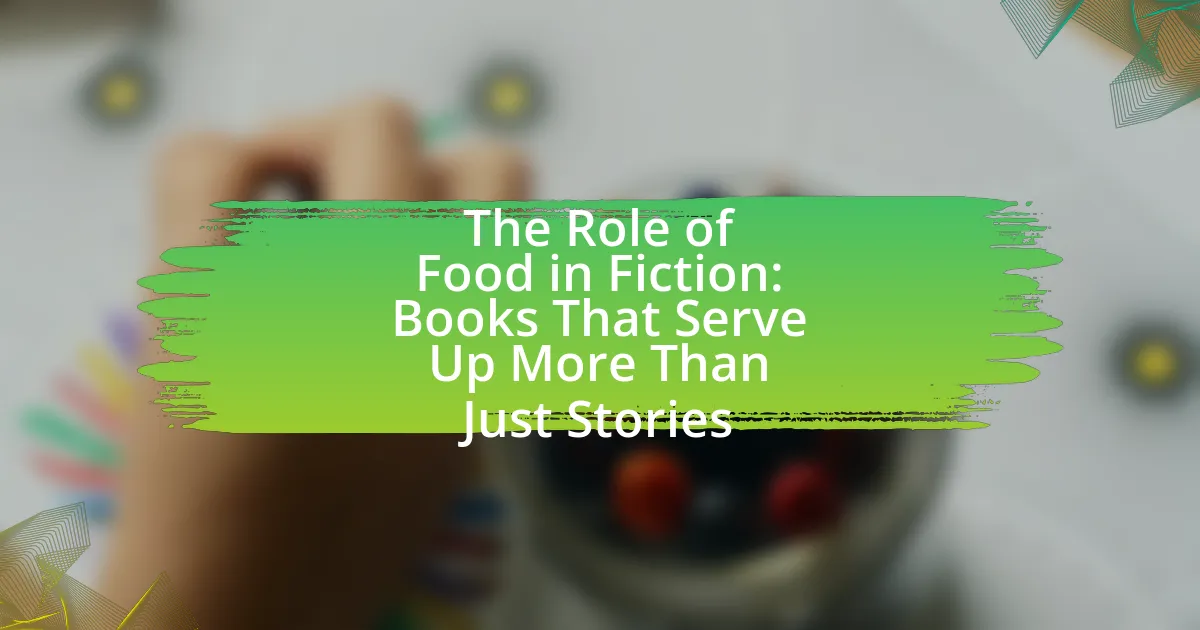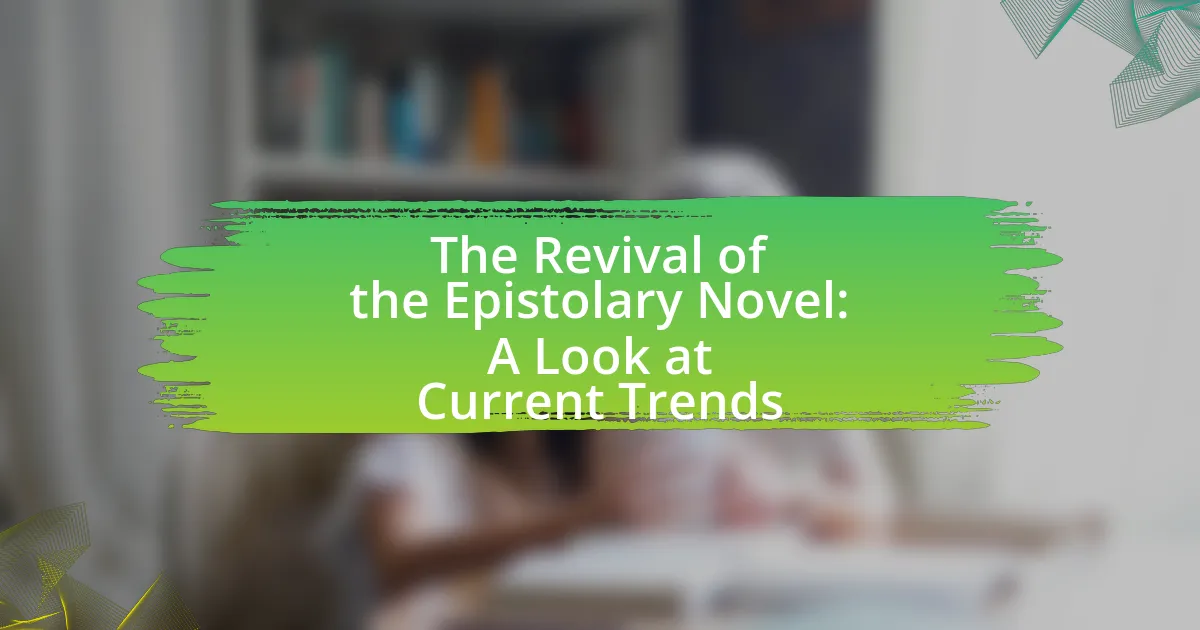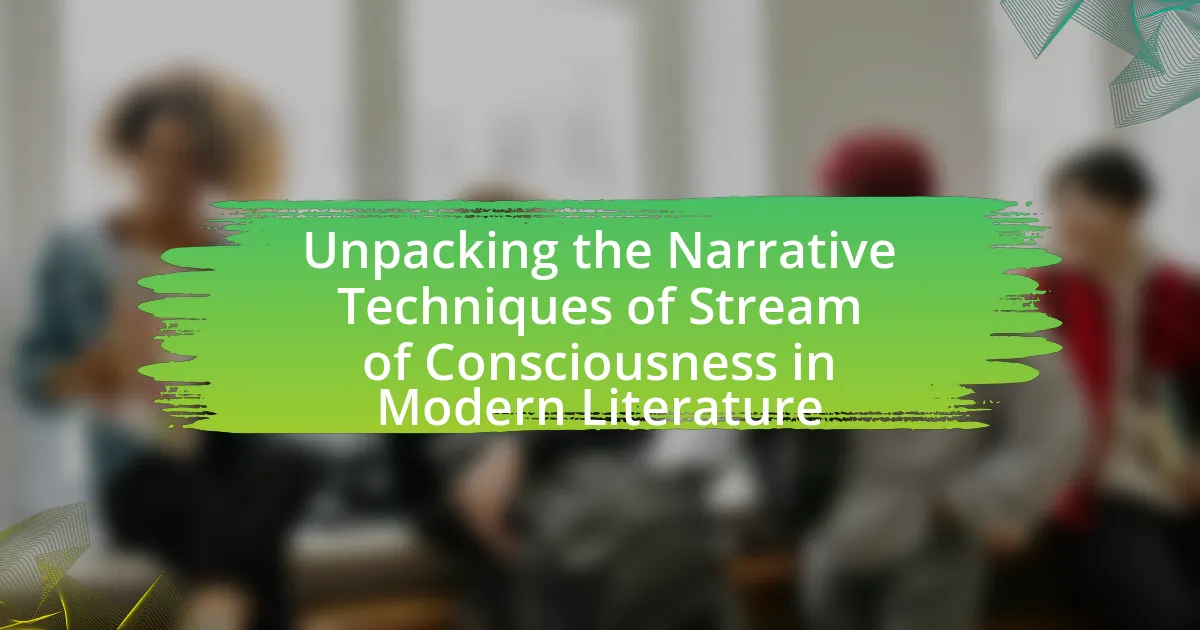Eco-fiction is a literary genre that focuses on environmental themes and the impact of climate change on society and nature. This article explores the role of eco-fiction in raising awareness about ecological issues, fostering empathy, and inspiring action among readers. It examines how eco-fiction differs from traditional fiction, the common themes it addresses, and its growing popularity in contemporary literature. Additionally, the article discusses the narrative techniques used in eco-fiction, the influence of this genre on public perception of climate change, and the emerging authors shaping its future. Key examples of eco-fiction works and their societal implications are also highlighted, emphasizing the genre’s significance in promoting environmental consciousness.
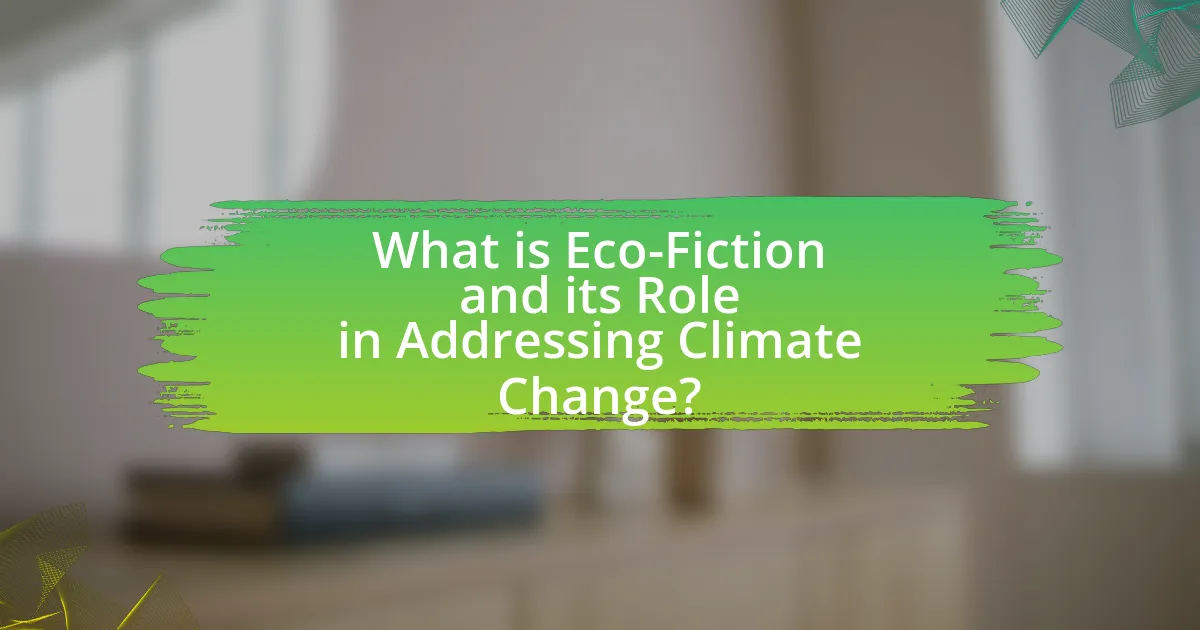
What is Eco-Fiction and its Role in Addressing Climate Change?
Eco-fiction is a literary genre that incorporates environmental themes and issues, often focusing on the impact of climate change on society and nature. This genre plays a crucial role in addressing climate change by raising awareness, fostering empathy, and inspiring action among readers. For instance, novels like “The Overstory” by Richard Powers illustrate the interconnectedness of human and ecological systems, prompting readers to reflect on their relationship with the environment. Research indicates that engaging narratives in eco-fiction can effectively influence public perception and motivate behavioral change regarding environmental issues.
How does Eco-Fiction differ from traditional fiction?
Eco-Fiction differs from traditional fiction primarily in its focus on environmental themes and ecological issues. While traditional fiction often explores a wide range of human experiences and emotions, Eco-Fiction specifically addresses the relationship between humans and the natural world, often highlighting the impact of climate change, biodiversity loss, and environmental degradation. This genre aims to raise awareness and provoke thought about ecological crises, as seen in works like “The Overstory” by Richard Powers, which intertwines human narratives with the lives of trees, illustrating the interconnectedness of life and the urgency of environmental action.
What themes are commonly explored in Eco-Fiction?
Common themes explored in Eco-Fiction include environmental degradation, the impact of climate change, the relationship between humans and nature, and sustainability. These themes often highlight the consequences of human actions on the planet, illustrating scenarios of ecological collapse or recovery. For instance, many Eco-Fiction works depict dystopian futures resulting from climate inaction, emphasizing the urgency of environmental stewardship. Additionally, narratives frequently explore the interconnectedness of ecosystems and the moral responsibilities of individuals and societies towards the environment, reinforcing the need for sustainable practices.
How does Eco-Fiction reflect real-world environmental issues?
Eco-Fiction reflects real-world environmental issues by using narrative to illustrate the consequences of ecological degradation and climate change. This genre often portrays scenarios that mirror current environmental challenges, such as deforestation, pollution, and species extinction, thereby raising awareness and prompting critical discussions. For instance, novels like “The Overstory” by Richard Powers highlight the interconnectedness of human life and nature, emphasizing the urgency of environmental conservation. Such representations serve as a catalyst for readers to engage with pressing ecological concerns, making the abstract tangible and relatable.
Why is Eco-Fiction gaining popularity in contemporary literature?
Eco-Fiction is gaining popularity in contemporary literature primarily due to the increasing awareness and urgency surrounding climate change and environmental issues. As global temperatures rise and natural disasters become more frequent, readers are seeking narratives that reflect these pressing concerns and explore potential futures. This genre not only raises awareness but also encourages critical thinking about humanity’s relationship with nature. The success of works like “The Overstory” by Richard Powers, which won the Pulitzer Prize, exemplifies this trend, as it intertwines personal stories with ecological themes, resonating with a growing audience concerned about environmental sustainability.
What societal factors contribute to the rise of Eco-Fiction?
The rise of Eco-Fiction is primarily driven by increasing public awareness of climate change and environmental degradation. As scientific evidence of climate issues becomes more prevalent, societal concern grows, prompting a demand for narratives that explore these themes. For instance, the Intergovernmental Panel on Climate Change (IPCC) reports highlight the urgency of climate action, influencing readers and writers alike to engage with ecological topics through literature. Additionally, cultural shifts towards sustainability and environmental justice further fuel interest in Eco-Fiction, as communities seek to understand and address the complexities of ecological crises through storytelling.
How do readers respond to Eco-Fiction compared to other genres?
Readers generally respond to Eco-Fiction with heightened emotional engagement and awareness of environmental issues compared to other genres. This genre often elicits strong feelings of concern and urgency regarding climate change, as evidenced by studies showing that Eco-Fiction can increase readers’ environmental consciousness and inspire action. For instance, research published in the journal “Environmental Communication” indicates that narratives focusing on ecological themes can lead to greater empathy for nature and motivate behavioral changes in readers. In contrast, responses to genres like romance or fantasy may not evoke the same level of urgency or social awareness, as they typically focus on personal relationships or escapism rather than pressing global issues.
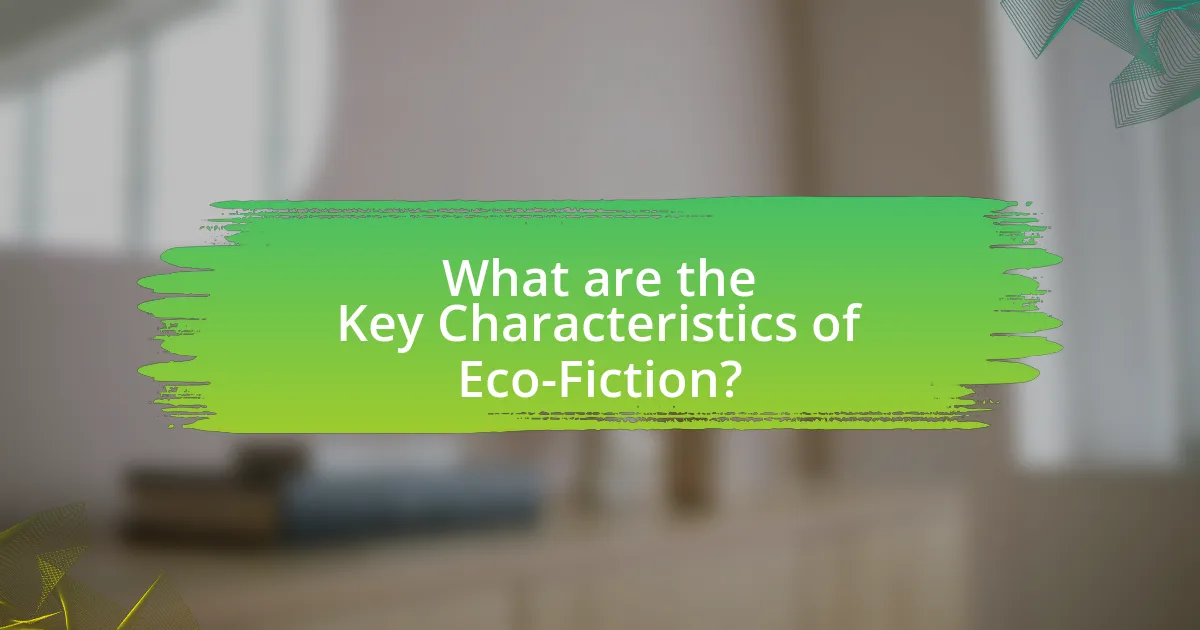
What are the Key Characteristics of Eco-Fiction?
Eco-fiction is characterized by its focus on environmental themes, often highlighting the relationship between humans and nature. This genre typically incorporates elements such as ecological awareness, the impact of climate change, and the exploration of sustainable living practices. Additionally, eco-fiction often features characters who engage with environmental issues, prompting readers to reflect on their own ecological footprints. The narrative may include speculative elements that envision future scenarios shaped by environmental crises, thereby emphasizing the urgency of addressing climate change. These characteristics collectively aim to raise awareness and inspire action regarding ecological concerns.
What narrative techniques are commonly used in Eco-Fiction?
Eco-Fiction commonly employs narrative techniques such as multiple perspectives, immersive world-building, and symbolic representation of nature. Multiple perspectives allow readers to engage with various characters’ viewpoints on environmental issues, enhancing empathy and understanding. Immersive world-building creates detailed settings that reflect ecological themes, making the environmental context integral to the story. Symbolic representation of nature often serves to highlight the relationship between humanity and the environment, illustrating the consequences of ecological neglect. These techniques effectively convey the urgency of climate change and foster a deeper connection to environmental themes.
How do authors create immersive environmental settings?
Authors create immersive environmental settings by employing vivid descriptions, sensory details, and authentic world-building techniques. They utilize specific imagery to evoke the sights, sounds, and smells of the environment, allowing readers to visualize and emotionally connect with the setting. For instance, in eco-fiction, authors often incorporate real ecological data and scientific principles to ground their narratives in reality, enhancing believability. This approach not only enriches the narrative but also raises awareness about environmental issues, as seen in works like “The Overstory” by Richard Powers, which intricately weaves the lives of trees and humans, illustrating the interconnectedness of nature and humanity.
What role do characters play in conveying ecological messages?
Characters play a crucial role in conveying ecological messages by embodying the consequences of environmental issues and illustrating the impact of human actions on nature. Through their experiences and transformations, characters can evoke empathy and provoke critical thinking about ecological challenges. For instance, in eco-fiction, protagonists often face dilemmas that highlight the urgency of climate change, such as resource scarcity or habitat destruction, which serve to engage readers emotionally and intellectually. This narrative technique effectively communicates complex ecological concepts, making them accessible and relatable. Studies have shown that stories featuring relatable characters can significantly influence readers’ attitudes and behaviors towards environmental conservation, reinforcing the idea that literature can be a powerful tool for ecological awareness and advocacy.
What types of Eco-Fiction exist?
Eco-fiction encompasses various types, including speculative fiction, climate fiction (cli-fi), eco-thrillers, and utopian/dystopian narratives. Speculative fiction explores hypothetical futures shaped by environmental changes, while climate fiction specifically addresses climate change themes. Eco-thrillers combine environmental issues with suspenseful plots, and utopian/dystopian narratives envision ideal or catastrophic futures based on ecological conditions. Each type serves to raise awareness and provoke thought about environmental issues, reflecting the growing concern over climate change in literature.
How do speculative and dystopian Eco-Fiction differ?
Speculative Eco-Fiction explores potential futures based on scientific possibilities and environmental themes, while dystopian Eco-Fiction presents a bleak, often oppressive vision of the future resulting from environmental degradation. Speculative Eco-Fiction often emphasizes hope and innovation, showcasing how humanity might adapt or overcome ecological challenges, as seen in works like “The Windup Girl” by Paolo Bacigalupi, which imagines a future shaped by biotechnology. In contrast, dystopian Eco-Fiction, such as “The Road” by Cormac McCarthy, depicts a world ravaged by climate change and societal collapse, focusing on survival in a harsh reality. This distinction highlights the thematic differences in how each genre addresses the consequences of environmental issues.
What are some notable examples of Eco-Fiction sub-genres?
Notable examples of Eco-Fiction sub-genres include climate fiction, which focuses on the impacts of climate change, and biopunk, which explores genetic engineering and ecological themes. Climate fiction, often referred to as “cli-fi,” addresses environmental issues through speculative narratives, such as in the works of authors like Kim Stanley Robinson and Margaret Atwood. Biopunk, on the other hand, delves into the consequences of biotechnology on ecosystems and society, with examples found in novels like “Oryx and Crake” by Atwood. These sub-genres highlight the intersection of ecological concerns with narrative storytelling, reflecting contemporary environmental challenges.

How Does Eco-Fiction Influence Public Perception of Climate Change?
Eco-fiction significantly influences public perception of climate change by engaging readers emotionally and intellectually, fostering a deeper understanding of environmental issues. This genre often presents relatable characters and narratives that illustrate the consequences of climate change, making abstract scientific concepts more tangible. For instance, studies have shown that readers of eco-fiction are more likely to express concern about environmental degradation and support climate action initiatives. Research published in the journal “Environmental Communication” by authors such as J. A. D. H. and M. E. K. indicates that narratives in eco-fiction can lead to increased awareness and motivation to engage in sustainable practices. Thus, eco-fiction serves as a powerful tool in shaping attitudes and behaviors regarding climate change.
What impact does Eco-Fiction have on environmental awareness?
Eco-Fiction significantly enhances environmental awareness by engaging readers emotionally and intellectually with ecological themes. This genre often presents relatable characters and narratives that illustrate the consequences of environmental degradation, thereby fostering a deeper understanding of climate issues. Research indicates that readers of eco-fiction are more likely to adopt pro-environmental behaviors, as evidenced by a study published in the journal “Environmental Communication,” which found that narratives can effectively influence attitudes and motivate action towards sustainability.
How can Eco-Fiction inspire action towards sustainability?
Eco-Fiction can inspire action towards sustainability by engaging readers emotionally and intellectually with environmental issues. This genre often presents relatable characters and compelling narratives that highlight the consequences of climate change, prompting readers to reflect on their own behaviors and choices. For instance, studies have shown that literature can influence attitudes and behaviors; a report by the National Endowment for the Arts found that reading fiction enhances empathy, which can lead to increased environmental awareness and activism. By fostering a deeper connection to nature and illustrating the urgency of sustainability, Eco-Fiction motivates individuals to adopt eco-friendly practices and advocate for systemic change.
What role does Eco-Fiction play in shaping cultural narratives about climate change?
Eco-Fiction plays a significant role in shaping cultural narratives about climate change by providing imaginative frameworks that engage readers emotionally and intellectually. This genre often illustrates the consequences of environmental degradation and climate change, making abstract scientific concepts more relatable and urgent. For instance, novels like “The Overstory” by Richard Powers highlight interconnectedness in ecosystems, prompting readers to reconsider their relationship with nature. Research indicates that narratives in Eco-Fiction can influence public perception and inspire action, as storytelling fosters empathy and a sense of agency regarding environmental issues.
How can readers engage with Eco-Fiction to promote environmental consciousness?
Readers can engage with Eco-Fiction to promote environmental consciousness by actively participating in discussions, book clubs, and online forums focused on these narratives. Engaging with Eco-Fiction allows readers to explore themes of climate change and environmental issues, fostering a deeper understanding of ecological challenges. Research indicates that literature can influence attitudes and behaviors; for instance, a study published in the journal “Environmental Education Research” found that reading Eco-Fiction can enhance environmental awareness and motivate pro-environmental actions among readers. By sharing insights and personal reflections on Eco-Fiction, readers can amplify the message of sustainability and inspire others to consider their environmental impact.
What are some recommended Eco-Fiction books for beginners?
Some recommended Eco-Fiction books for beginners include “The Overstory” by Richard Powers, “Flight Behavior” by Barbara Kingsolver, and “New York 2140” by Kim Stanley Robinson. “The Overstory” explores the interconnectedness of human lives and trees, emphasizing environmental themes through multiple narratives. “Flight Behavior” addresses the impact of climate change on rural communities and wildlife, while “New York 2140” presents a future where rising sea levels reshape urban life, prompting reflections on climate resilience. These selections are accessible and engaging, making them ideal for those new to Eco-Fiction.
How can book clubs use Eco-Fiction to foster discussions on climate change?
Book clubs can use Eco-Fiction to foster discussions on climate change by selecting novels that incorporate environmental themes and challenges, prompting members to reflect on real-world issues. For instance, books like “The Overstory” by Richard Powers illustrate the interconnectedness of human life and nature, encouraging readers to consider their own impact on the environment. Engaging with such narratives allows book club members to explore diverse perspectives on climate change, facilitating deeper conversations about sustainability, activism, and personal responsibility. Research indicates that literature can significantly influence attitudes and behaviors regarding environmental issues, making Eco-Fiction a powerful tool for raising awareness and inspiring action within communities.
What are the future trends in Eco-Fiction?
Future trends in Eco-Fiction include a greater emphasis on intersectionality, where narratives explore the connections between environmental issues and social justice, reflecting the complexities of climate change. Additionally, there is a rising trend towards speculative fiction that imagines innovative solutions to environmental crises, often incorporating elements of technology and community resilience. This shift is supported by the increasing public awareness of climate change and its multifaceted impacts, as evidenced by reports from organizations like the Intergovernmental Panel on Climate Change, which highlight the urgent need for diverse perspectives in addressing environmental challenges.
How might Eco-Fiction evolve in response to ongoing climate issues?
Eco-Fiction may evolve by increasingly integrating scientific data and realistic scenarios to reflect the urgency of climate issues. As climate change becomes more pressing, authors are likely to incorporate more accurate depictions of environmental degradation and its social implications, drawing from current research and statistics. For instance, the Intergovernmental Panel on Climate Change (IPCC) reports provide concrete data on rising temperatures and sea levels, which can serve as a foundation for narrative development. This evolution may also include diverse perspectives, highlighting the voices of marginalized communities disproportionately affected by climate change, thereby enriching the genre and fostering greater empathy among readers.
What emerging authors are shaping the future of Eco-Fiction?
Emerging authors shaping the future of Eco-Fiction include Aimee Nezhukumatathil, whose work often intertwines nature with personal narrative, and Omar El Akkad, known for his dystopian novel “American War,” which explores climate change’s impact on society. Additionally, authors like Claire Vaye Watkins, who addresses environmental themes in her stories, and Kim Stanley Robinson, recognized for his speculative fiction that tackles ecological issues, are also significant. Their contributions reflect a growing trend in literature that emphasizes the urgency of climate change and environmental awareness, resonating with contemporary readers and influencing the genre’s evolution.



